Dockside lifting: Port report
07 August 2018
A trend towards electrification and automation can be seen in the dockside lifting sector’s latest products and projects. CHRISTIAN SHELTON reports
Big news in the dockside lifting sector is the launch of an electric crane from Liebherr. The company says the new LPS 420 E is its first purely electric port crane. All crane movements, including luffing, hoisting, slewing and travelling, are powered by electric motors. The crane is suitable for ports and terminals that have a power supply infrastructure ranging from 380 to 460 Volts.
The LPS 420 E is part of the LHM series which, Liebherr explains, means it is characterised by a high degree of modularity. As such, it can be used to handle all types of cargo and for lifts up to 124 tonnes. It has two winches, each with a 190 kW electric motor.
Configured for bulk handling, the LPS 420 E has a turnover of up to 1,200 tonnes per hour and has an outreach of up to 48 metres, says Liebherr. This means that it can effectively serve ships up to the Panamax class in size.
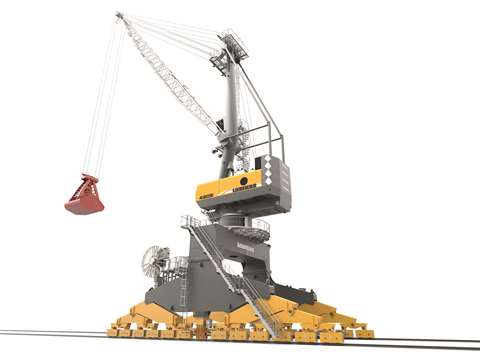
The main components of the electric drive are liquid cooled and the heat is dissipated by heat exchangers. The closed liquid cooling system and heat exchanger are installed on top of the slewing platform. Liebherr says this means an overpressure unit is not required to prevent the ingress of dust.
Box handling
When it comes to container handling, Liebherr says the LPS 420 E can handle up to 30 cycles per hour. It says the crane has a low moment of inertia and a fast motor response to facilitate quick, accurate operation. Due to the high motor speed spread, no gear shifting between normal and heavy load is required, Liebherr explains, and there is little noise from the planetary gearbox.
A Liebherr-built active-front-end frequency converter means any variations in the electricity supply can be compensated for, while the crane’s energy storage units can be used to reduce the peak-load in the main power supply and to take advantage of regenerative energy within the system. The unit is compact and ensures a high power storage capacity, which enables the accumulation and supply of 200 kW of power within 15 seconds, says Liebherr.
Kalmar, the port-focused branch of cargo and load handling solutions provider Cargotec, has been busy providing port equipment around the world. In Poland, the Deepwater Container Terminal (DCT) Gdansk has purchased five customised electrically-powered rubber-tyred gantry cranes (RTGs). In Sweden, Kalmar has been awarded a full outsourcing contract for maintenance activities at Yilport Holding’s three cargo terminals where Yliport operates more than 70 types of cargo handling equipment under several brands. In Norway, Kalmar has been awarded a contract for the automation retrofit of two rubber-tyred gantry cranes for the port of Borg Havn IKS. While, in Indonesia, it has concluded a deal with Riau Andalan Pulp & Paper (RAPP) to supply three SmartPower rubber-tyred gantry cranes for RAPP’s container yard at the Port of Buatan.
On the equipment front, Kalmar has announced the launch of its latest-generation of shuttle and straddle carriers. According to Kalmar the next-generation machines have new mobile drives, a redesigned electrical system for the upper frame and spreader, a more spacious electrical cabinet layout, and LED working lights as standard. Kalmar says its shuttle and straddle carriers now share common electrical components and technical solutions, making maintenance easier and more cost-efficient for customers operating both types of machines.
Automated solutions
Kalmar is also introducing an electric automated guided vehicle (AGV) solution for transporting containers between quayside and landside operations: the Kalmar FastCharge AGV. It is constructed on a steel platform which can carry one or two 20-foot containers, one 40- or 45-foot container, and handle loads of up to 70 tonnes. The AGV’s electric power system uses lithium-ion batteries.
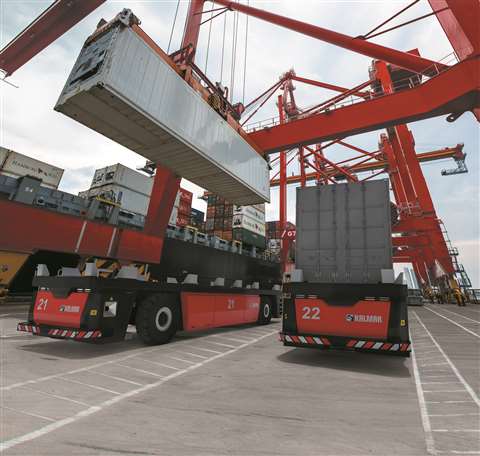
Kalmar is also busy providing port equipment around the world. In Poland, the Deepwater Container Terminal (DCT) Gdansk has purchased five customised electrically-powered rubber-tyred gantry cranes (RTGs). In Sweden, it has been awarded a full outsourcing contract for maintenance activities at Yilport Holding’s three cargo terminals where Yliport operates over 70 different types of cargo handling equipment from several different brands. In Norway, Kalmar has been awarded a contract for the automation retrofit of two rubber-tyred gantry cranes for the port of Borg Havn IKS. While in Indonesia, it has concluded a deal with Riau Andalan Pulp & Paper (RAPP) to supply three SmartPower rubber-tyred gantry cranes for RAPP’s container yard at the Port of Buatan.
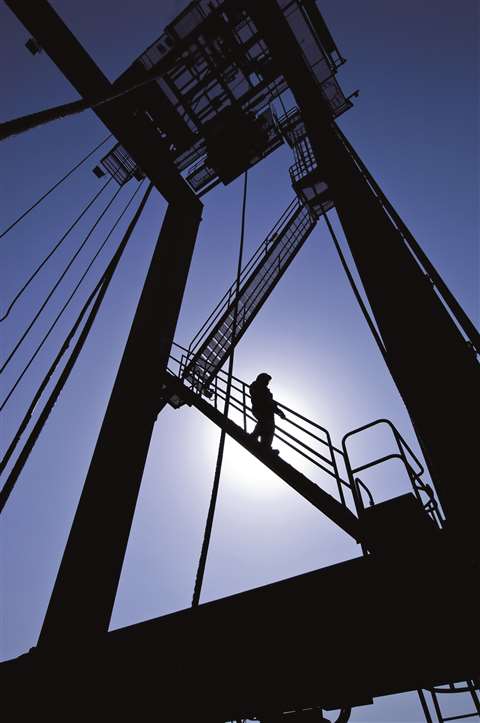
Leading Chinese container and bulk cargo handing machinery manufacturer ZPMC has also been developing new products and new markets, with a focus on automation.
At the end of 2017 the Shanghai Yangshan Phase IV Automated Container Terminal opened for trial operation. According to ZPMC, it is the world’s largest and most automated terminal. It was built by ZPMC and Shanghai International Port Group (SIPG).
ZPMC provided 10 automated STS cranes, 40 automated rail mounted gantry (RMG) cranes, 50 AGVs, and 58 automated RMG cranes, as well as all associated software. It also supplied a new product: an automated double-container RMG.
At the end of 2017 ZPMC completed its work at the Singapore Port Authority, where it provided 130 automated RMGs ahead of schedule. ZPMC has also won a contract to automate the Tianjin Wuzhou International Terminal Container Terminal in China.
ZPMC says it has also developed an autonomous unmanned container straddle carrier. The carrier doesn’t need any magnetic guides and can avoid objects, slow down, brake, and plan the optimal route across a terminal for the transportation of containers. ZPMC says the potential market for autonomous driving straddle carriers is huge and it hopes to sell the equipment to ports and terminals around the world.
Port buys Liebherr LHM 420 mobile harbour crane
Shannon Foynes Port Company, based in the west coast of Ireland, has bought a new Liebherr LHM 420 mobile harbour crane. The crane was procured through a tender process, says Liebherr, and was delivered fully assembled.
It will be primarily used for the handling of bulk products and has a grab curve of 75 tonnes, while lifting capacity is 124 tonnes. An air pressure system helps prevent the ingress of dust. The new crane will also be used to handle project cargo, in particular wind turbines. Due to the port’s close proximity to the town of Foynes, the crane had to almost silent, so additional sound proofing was installed.
Shannon Foynes Port Company CEO Pat Keating comments, “This piece of equipment is future-proofing the port. The greater lift capacity and reach it provides us with enables us to bring in new business. That means more ships, bigger ships and processing them with faster turnaround times.”

Shannon Foynes Port Company’s Liebherr LHM 420
Electric Ottawa T2 terminal tractor from Kalmar
Kalmar has also announced it will introduce an electric version of its Kalmar Ottawa T2 terminal tractor. The Kalmar Ottawa Electric Terminal Tractor is designed for trailer-handling operations in dispersed warehouses, container terminals and other applications where short-distance highway travel is required. According to Kalmar, it has the latest battery technology, a fully electric powertrain and a comfortable driving environment.

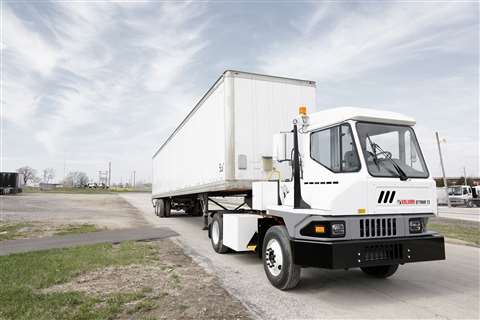
Finnish lifting equipment manufacturer Konecranes has won an order for two Model 8 Gottwald floating cranes. The order was placed by Singapore-based Winning Logistics Company (WLC) which will use the cranes for bauxite handling off the coast of Guinea in Africa. This follows an order WLC placed in autumn 2017 for six Gottwald floating cranes. The Model 8 has a maximum outreach of 43 metres and a 63 tonne grab curve. They can operate at wind speeds of up to 24 m/s and at maximum wave heights of 2.5 m.
Konecranes has also received an order for a Gottwald Model 2 mobile harbor crane to handle containers and general cargo in the port of Baro, Nigeria. The crane was bought by Nigerian company First Index Project and Services, which is operating as a public sector supplier. The diesel-electric Model 2 two-rope crane has a maximum lifting capacity of 80 tonnes and an outreach of up to 40 m.

Winning Logistics Company has ordered two more Model 8 Gottwald Floating Cranes
Sarens rearranges port
International container terminal operating company APM Terminals has taken delivery of four new gantry cranes at North America’s second-busiest port facility – the Port Elizabeth terminal in New Jersey. According to APM Terminals, the new gantry cranes, manufactured by ZPMC, will enable it to better serve larger ships. The cranes reach 23 containers across the vessel beam and are part of the facility’s USD $200 million infrastructure investment plan scheduled for completion this year.
Heavy lift and transportation specialist Sarens was commissioned to relocate the 1,700 tonne cranes once they arrived at the port. To do this, Sarens used 132 axle lines of Kamag 2400 SPMT and six large power packs. To make room for the new cranes, Sarens first had to move four existing cranes to a new location. It then picked up each of the new STS cranes, moved them away from the quay, rotated them by 90 degrees, moved them to their new location and lowered them into place.
In related news, Sarens has formed a joint venture (JV) with Turkish shipping and logistics agency Makzume. In port Makzume provides services from stevedoring to custom clearance services for containers and even car carrier giants. The JV will make cranes, SPMT, and barges available for rent and for special projects. Markets served include Romania, Turkey, Georgia, Azerbaijan, Turkmenistan, Uzbekistan, Syria, Lebanon, and Libya.
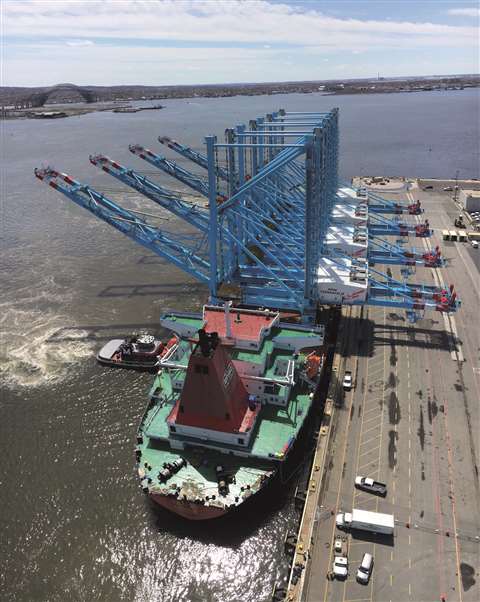
Ortiz Fischer uses Modulift spreader beams at Ingeniero Buitrago port
Argentinian hoisting and load securing specialist Ortiz Fischer designed a rig for faster loading of steel coils at the Ingeniero Buitrago Port in Argentina.
Ortiz Fischer used two Modulift spreader beams, allowing two coils to be lifted at once. Mod 24 and 34 beams were combined in a narrow rig with slings and other equipment. The two 12 tonne coils were lifted together, using a 30 tonne crane, halving the time taken to complete loading operations. Ortiz Fischer also provided grade 10 chains, wire rope slings, and Green Pin shackles.
According to Sue Spencer, technical director at Modulift, “Using two spreader beams in this type of rig configuration is not that common; however, it is a great idea for lifting steel coils in this way to speed up loading time. The steel coils keep the beams spaced apart, and it is a good idea if there is the headroom available to have very long slings for this type of rig to minimise the horizontal forces being transferred to the load being lifted due to having angled slings. The coils themselves are more than strong enough to withstand these horizontal ‘crushing’ forces.”
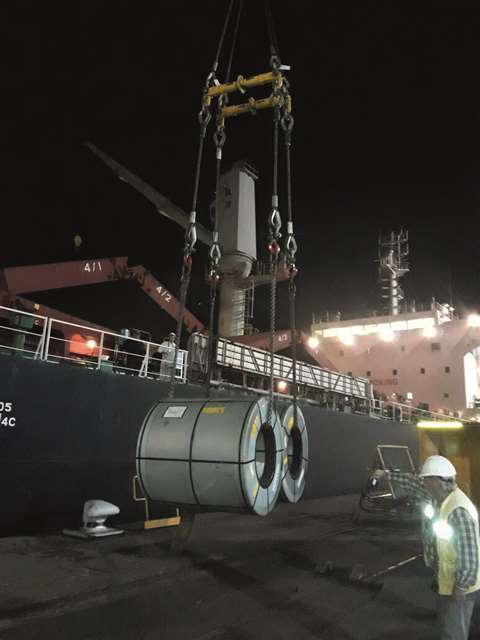
Aegir undertakes heavy lifts at the Port of Tyne
The deep-water heavy lift vessel Aegir, operated by Netherlands-based Heerema Marine Contractors (HMC), will undertake a number of complex heavy lifting operations at the Port of Tyne’s Northumbrian Quay in North Shields, UK.
The 4,000 tonne heavy lift capacity vessel will be at the port for around two weeks, during which time a number of wind turbine jackets will be transported down the river Tyne from steel construction company Smulders Projects UK, based in Wallsend. The jackets, which measure between 68 – 81 metres high and weigh 1,300 tonnes, have been constructed by Belgian-owned Smulders UK as part of the European Offshore Wind Deployment Centre, off Aberdeen in Scotland.
The jackets will arrive by barge. The Aegir will then come alongside the barge and lift them off one at a time, deploying its 125-metre-long, 96-metre-high main crane.
The revolving mast type crane is made by Huisman and has a capacity of 4000 tonnes between 17-40 m radius and 1500 tonnes at a 78 m radius. The crane’s maximum radius is 79 m.
Once each jacket has been secured, the Aegir will sail to Scotland with the jacket suspended from its crane, over the side of the vessel, before returning to repeat the operation with the remaining jackets.
Aegir is expected return from Scotland every three days to complete a total of five lifting operations at the Port of Tyne.







